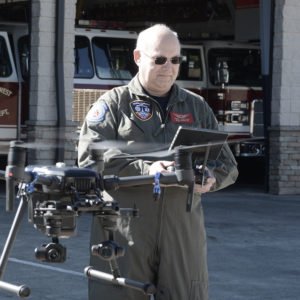
The following is one of a biweekly serieson public safety drone issues by Steve Rhode, Chief Pilot with the Wake Forest Fire Department and the North Carolina Public Safety Drone Academy, and founder of Public Safety Flight, a website dedicated to information about the use of unmanned aircraft systems (UAS), UAVs, aircraft, and drones in public safety. (Not to be contrued as legal advice: please see details at the FAA government site. Opinions are the author’s.)
Can You Handle the Truth? Verifying Drone Marketing Claims
This morning I was reminded of that great line from A Few Good Men, “You can’t handle the truth.”
My primary goal is always to make sure all public safety pilots are as safe as possible and minimize their FAA and civil liability as much as possible.
Since drones in public safety are so new, shiny, and exciting, there appears to be a blind acceptance of what messages tech companies deliver in their marketing and what others say.
My message is that all pilots should always keep that Ronald Regan phrase in mind, “Trust, but verify.”
When pilots, or government attorneys, take the time to verify the information being shared in drone marketing or among fellow pilots, they often run into an inconvenient truth; the marketing statements lack detail or are just inaccurate.
The Truth About BVLOS Flight
For example, when it comes to Beyond Visual Line of Sight (BVLOS) flight, manufacturer marketing can leave the reader with the impression there are new advances in BVLOS flight using some aircraft models.
However, what seems to be missing from those messages is a Visual Observer (VO) is still required. BVLOS only applies to the drone pilot but not the flight.
For example, recently, there has been a lot of hype about a new BVLOS approval. What has been missing from the messages is the actual waiver requires some poor sap to sit in a boat to be the VO when the drone flies from one spot over water to another location.
As the public safety pilot, the only person looking out for you is you.
Tech companies want to sell drones, and their marketing messages do not have to abide by the FAA flight rules.
The FAA is responsible for ensuring the National Airspace System is safe, and all pilots are flying by the rules. If not, fines, penalties, and more can occur.
Ignorance is never a good defense. “That’s what the salesperson told me” is not going to protect you when a citizen files a complaint or you crash.
You must verify any claim you depend on actually complies with flight rules. Don’t assume. Find the truth, and if you need some help or advice, you can reach me through the PSFlight.org website. I’m always here to help my pilot peers.
Last week I flew a low-level water rescue exercise that was challenging and had risks. Even though the flight in the airplane was risky if I lost an engine, the entire flight was within the FAA operating rules.
If you compare that with a typical public safety drone flight that can violate many rules, there is no doubt that flying a drone today and making assumptions the flight is within the regulations is not a wise move.
Amazing drones that will give us exceptional capabilities are coming. They are not here today. Can you handle that truth?
Miriam McNabb is the Editor-in-Chief of DRONELIFE and CEO of JobForDrones, a professional drone services marketplace, and a fascinated observer of the emerging drone industry and the regulatory environment for drones. Miriam has penned over 3,000 articles focused on the commercial drone space and is an international speaker and recognized figure in the industry. Miriam has a degree from the University of Chicago and over 20 years of experience in high tech sales and marketing for new technologies.
For drone industry consulting or writing, Email Miriam.
TWITTER:@spaldingbarker
Subscribe to DroneLife here.